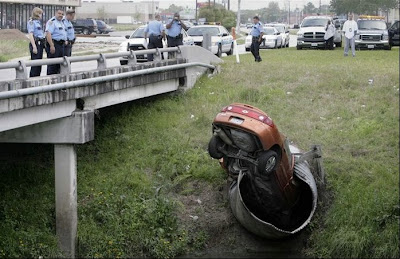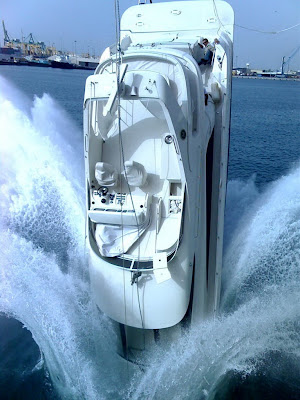'Windshield bullies' a growing fraud problem
14 Nov 2012 10:37am, EST
|
NBCNews.com
|
Some people call them "windshield bullies."
They hover outside car washes, wander around office parking lots or sometimes even go door to door. They find a chip in your windshield, then launch into a hard sell for instant replacement.
Complaints about windshield bullies come from all around the country but are particularly common in places like Florida and Arizona. Just this week, the Tallahassee, Fla., Police Department issued a warning about door-to-door salesmen after a series of unexpected doorbell sales pitches were reported by residents.
The salesmen aren't necessarily criminal. In fact, windshield incidents run the spectrum from legitimate, convenient replacement, to overly aggressive marketing, to outright fraud. In some cases, the salespeople are accused of damaging windshields, then ringing door bells and offering to repair them.
There's big money in windshield fraud. Last year, a Florida woman in Hernando County accused of damaging windshields told police that she earned $45 for every sales referral – not a bad take, given that online referrals for items like mortgages typically earn tipsters only $5 or $10 apiece.
But firms don't need to engage in property damage to make big money off of auto glass insurance fraud.
In 2008, a Washington state glass company named DKN Industries pleaded guilty to lying about the geographic location of the repairs it performed in order to earn higher commissions (rural repairs get a premium over urban repairs). During a three-year stretch, the firm received an extra $6 million in insurance payments that way. And last year, the vice president of Florida-based Lee and Cates Glass Inc. was among 10 people arrested and charged with filing half a million dollars in false claims, allegedly lying about the quality of the glass the firm installed.
Erin Klug, the spokeswoman for the Arizona Department of Insurance, said she had a door-to-door sales agent ring her door bell not long ago, offering to replace her windshield.
"They didn't stay long," she said. "They couldn't even see my car, it was in the garage."
Windshield chips are a way of life in Arizona, where desert driving often takes a toll on auto glass. That makes the state a prime target for aggressive repair services.
"There is a very real problem with auto glass fraud in Arizona and elsewhere," said Klug. Door-to-door sales are a new flavor of the old problem, she said, but some firms have recently taken to aggressive telemarketing in Arizona, too.
In a particularly egregious version, Kluz said, consumers who've agreed to have their glass repaired by a disreputable firm are visited a week or two later by confederates and told the glass was installed incorrectly. They are then persuaded to allow a second replacement, giving the firm a second bite at an insurance claim on the same car.
It's nearly always a bad idea to pay for a service you weren't planning to buy when solicited by a "surprise" sales pitch, such as door-to-door roof repairs. Consumers should always research such purchases, and get a couple of competitive bids. If the sales pitch is at all tempting, get a business card, go home, do some research and call the firm tomorrow.
An area ripe for fraudBut high-pressure, on-the-spot sales firms are particularly attracted to auto glass repairs because insurance rules make things easy for them. In so-called "zero deductible" states -- Florida, Kentucky, Massachusetts and South Carolina -- insurance companies are required to pay the full cost of windshield repair for drivers holding comprehensive coverage. That enables instant repair sales firms to give a great pitch: "We can fix this for free! We'll even do all the paperwork."
Even in states where a deductible of $50 or $100 might apply, the profit margins on glass replacement are so high that firms can swallow that payment and still earn a hefty return. Craig Fairfield, a special agent for the National Insurance Crime Bureau in Washington state, said replacement glass can cost as little as $50 to $75, but insurance reimbursement is often $300 or more.
As a result, he said, door-to-door sales can be lucrative.
Last November, a company named Go To Inc. announced in a press release that it was expanding operations using that mode.
"Go To, Inc. follows a marketing model unlike most traditional auto glass companies," it said. "The company does not use conventional advertising; instead its marketing efforts consist of face-to-face meetings generated from visiting businesses in an area where a windshield replacement or repair has been scheduled."
Go To said it had a marketing partnership with a firm named Coast to Coast Auto Glass, one of the larger firms in the door-to-door sales space. Coast to Coast has been the target of numerous complaints online, and the firm currently has an F rating with the Florida Better Business Bureau.
Rhonda Jacobson, a spokeswoman for Coast to Coast, said the firm takes complaints seriously.
"At Coast to Coast Auto Glass, direct customer service and satisfaction is a priority," Jacobson wrote in an e-mail. "Any customer queries or complaints that come into our corporate offices/headquarters in Chandler, Ariz., are investigated and handled immediately. Unfortunately, there is often no way for Coast to Coast to respond to grievances that are posted anonymously online or to those that are never sent into our corporate offices. Specifically, with regards to local BBB complaints, Coast to Coast is in the process of contacting all local bureaus in the appropriate markets to ensure that they have the correct contact information."
Klug said high-pressure glass sales take many forms in Arizona. In some cases, drivers are approached at gas stations, with a seemingly helpful employee offering to wash the driver's windows, then discovering chips and offering replacement service. In many cases, the sales agent is an invited guest of the station owner, who might earn commissions for sales. Others are trespassers, she said.
While door-to-door glass repair outfits can be perfectly legitimate, Klug said consumers have a lot to fear from them. Improperly installed glass can pose a safety hazard. Unnecessary repairs -- many drivers complain these agents see defects that aren't there -- lead to unnecessary claims and raise insurance rates for everyone. And in one flavor of the scam, the repair firm asks the consumer to pay up front, promising full reimbursement from the insurance firm, which never comes.
And that's not all.
"There have been cases where people's insurance ID cards are stolen, and claims submitted, when there was no repair done at all," she said. In other cases, the firm merely plugs a small glass chip, but submits a bill for full replacement.
And there's another possibility drivers should fear: While glass repair claims generally don't cause rate increases, obviously an insurer will find a way to ding a driver who makes excessive claims. Allowing a firm to unnecessarily replace your windshield could come back to haunt you when you really need it done.
RED TAPE WRESTLING TIPSKlug said drivers who have windshield imperfections that interfere with driving should have their glass repaired as soon as possible. Drivers can pick any glass company they wish, but she strongly recommends making arrangements with the insurance company first.
"We encourage you to file a claim and make those arrangements first," she said.
Fairfield, the insurance crime bureau agent, said consumers should make sure to get and read documentation and warranty information from any glass repair firm before agreeing to have work done.
"The most important thing is to try to get something in writing from the vendor, have them explain the type of glass that is being used. Make sure it is OEM -- original equipment manufacturer -- glass so that it will be safe and hold up in event of accident," he said.








